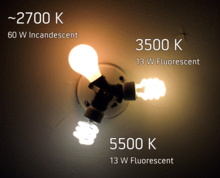Spectral G-index
The spectral G-Index is a variable that was developed to quantify the amount of short
Definition

The G-index is grounded in the system of astronomical photometry, and is defined as follows:[1]
where
- G is the spectral G-index;
- λ is the wavelength in nanometers;
- E is the spectral power distribution of the lamp;
- V(λ) is the luminosity function
The sums are to be taken using a step size of 1 nm.[1] For lamps with absolutely no emissions below 500 nm (e.g. Low Pressure Sodium or PC Amber LED), the G-index would in principle be undefined. In practice, such lamps would be reported as having G greater than some value, due to the limits of measurement precision. The Regional Government of Andalusia has developed a spreadsheet[3] to allow calculation of the G-index for any lamp for which the spectral power distribution is known, and it can also be calculated in the "Astrocalc" software[4] or the f.luxometer web app.[5]
The G-index does not directly measure light pollution, but rather says something about the color of light coming from a lamp. For example, since the equation defining G-index is normalised to total flux, if twice as many lamps are used, the G-index would not change; it is a measure of fractional light, not total light. Similarly, the definition of G-index does not include the direction in which light shines, so it is not directly related to skyglow, which depends strongly on direction.[6]
Rationale
The ongoing global switch from (mainly) orange
The problem with these approaches is that CCT is not perfectly correlated with blue light emissions. Lamps with identical CCT can have quite different fractional blue light emissions.
Use
In 2019, the
The G-index is planned to be used by the Regional Government of Andalusia, specifically for the purpose of protecting the night sky. Depending on the "environmental zone", the regulation requires lighting to have a G value above 2, 1.5, or 1. In areas where astronomical activities are ongoing, it is expected that only monochromatic or quasi-monochromatic lamps will be used, with G>3.5 and in principle only emissions in the interval 585-605 nm.[1]
Questionable Use Warning
The G-index has not been evaluated or adopted by a standards development organization (SDO), such as the CIE. Generally, for a specification to be used in a regulation or tender, it must go through the rigorous process of evaluation and adoption by an SDO. It is thus questionable for the EC Joint Research Center and the Andalusian Regional Government (and others) to suggest or prescribe mandatory requirements based on the G-index.
A measure focused solely on reducing blue light will not provide ecological protection. Because the intensity of light plays a role as strong or stronger than spectrum, putting the light in the right places (on road surfaces and sidewalks) and avoiding spillage into ecological regions is likely to be more effective than manipulating the spectrum of the light. Spectrum does play a role, but in order to prevent disturbance to sensitive animals, changes must be made to the spectrum which cannot be described by the G-index. Those changes are also species dependent. A specific (red-dominant) spectrum has been proven to be as good as darkness for many (but not all) light sensitive insect and bat species.[16][17][18] An amber spectrum is proven to be less eco-friendly than a red spectrum for some species, although both have negligible blue content and ‘favorable’ G index. Therefore the use of spectral G-index is overly simplistic and may do more harm than good. The use of the G-index is therefore strongly discouraged for use in lighting specifications or regulations.
References
- ^ a b c d Junte de Andalucia (2018). Índice espectral G (PDF) (Technical report). Retrieved 12 February 2019.
- ^ S2CID 73564862.
- ^ "Índice espectral G". www.juntadeandalucia.es (in European Spanish). Retrieved 2019-04-01.
- ^ "LICA AstroCalc - Comparador de filtros y cámaras". carlostapia.es. Retrieved 2019-04-01.
- ^ "f.luxometer". Retrieved 2019-04-29.
- ^ PMID 25780231.
- PMID 29124824.
- ^ Kinzey, Bruce; Perrin, Tess; Miller, Naomi; Kocifaj, Miroslav; Aubé, Martin; Solano Lamphar, Héctor (2017). An Investigation of LED Street Lighting's Impact on Sky Glow (Technical report). Pacific Northwest National Lab. PNNL-26411. Retrieved 12 February 2019.
- .
- ^ Longcore, Travis; Rich, Catherine; DelBusso, Leigha (2016). Artificial Night Lighting and Protected Lands / Ecological Effects and Management Approaches (Technical report). NPS/NRSS/NSNS/NRR--2016/1213. Retrieved 12 February 2019.
- S2CID 48364989.
- ^ "Fixture Seal of Approval". International Dark-Sky Association. Retrieved 12 February 2019.
- ^ "Arrêté du 27 décembre 2018 relatif à la prévention, à la réduction et à la limitation des nuisances lumineuses | Legifrance". www.legifrance.gouv.fr. Retrieved 12 February 2019.
- ^ a b c d Donatello, Shane; Rodríguez Quintero, Rocío; Gama Caldas, Miguel; Wolf, Oliver; Van Tichelen, Paul; Van Hoof, Veronique; Geerken, Theo (2019). Revision of the EU Green Public Procurement Criteria for Road Lighting and traffic signals (PDF) (Technical report). Joint Research Centre. EUR 29631 EN. Retrieved 12 February 2019.
- PMID 23861808.
- PMID 28566484.)
{{cite journal}}: CS1 maint: multiple names: authors list (link - S2CID 49421077.)
{{cite journal}}: CS1 maint: multiple names: authors list (link - S2CID 210303101.)
{{cite journal}}: CS1 maint: multiple names: authors list (link
External links
- More information, including a spreadsheet for calculating G-index, Regional Government of Andalusia (note: Spanish language page; English language handbook on index G, and LibreOffice spreadsheet in English for index computation, are linked from the lower part of the page.)
- Information on Green Public Procurement of Street Lighting in the EU, Joint Research Centre
- f.luxometer web tool, Online calculator for g-index and other indexes
- Astrocalc software, Carlos Tapia Ayuga (note: Spanish language page, English instructions at bottom)

